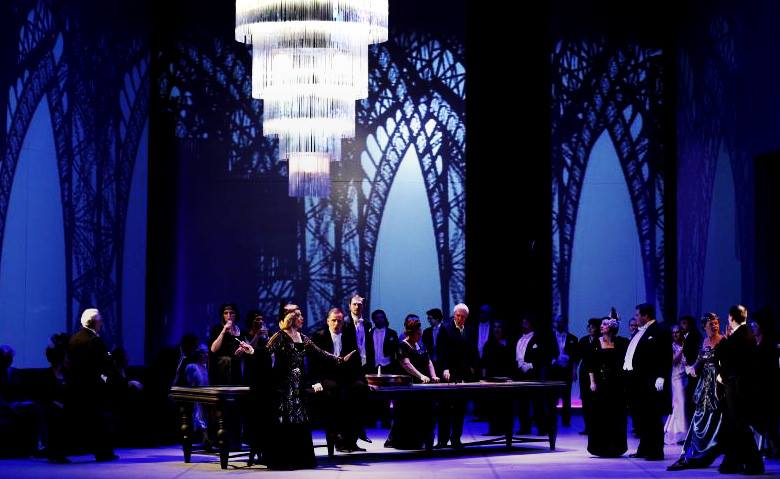Giuseppe Verdi: La Traviata The Baltic Opera – Danzica 3 Ottobre 2015 ITA-ENG
Giuseppe Verdi
LA TRAVIATA
The Baltic Opera, Danzica
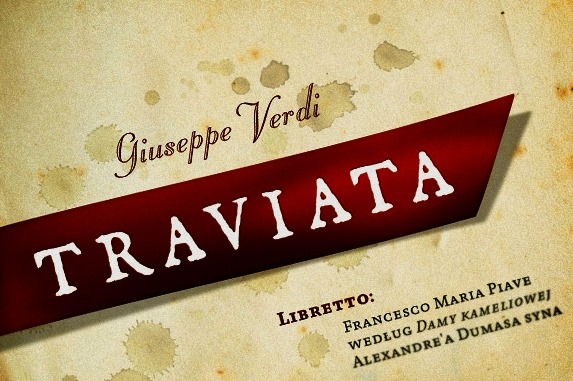 Direttore d’Orchestra: Jakub Kontz
Direttore d’Orchestra: Jakub Kontz
Regia: Karolina Sofulak
Scene e costumi: Hanna Szymczak
Coreografia: Roman Komassa
Disegno luci: Piotr Miszkiewicz
Multimedia: Marek Zygmunt
personaggi e Interpreti:
- Violetta Valéry : Aleksandra Kubas-Kruk
- Alfredo Germont: Paweł Skałuba
- Flora Bervoix: Karolina Sikora
- Giorgio Germont: Leszek Skrla
- Annina: Julia Iwaszkiewicz
- Gastone: Aleksander Kunach
- Barone Duphol: Daniel Borowski
- Marchese d’Orbigny: Bartłomiej Misiuda
- Dottor Grenvil: Andrzej Malinowski
- Commissionario: Rafał Sambor
- Giuseppe, servo di Violetta: Krzysztof Rzeszutek
- Una Zingara: Elżbieta Czajkowska-Kłos
Orchestra del The Baltic Opera di Danzica
Coro del The Baltic Opera di Danzica
Maestro del Coro: Anna Michalak
La Traviata dal Mar Baltico
Sabato 3 ottobre sono stata a Danzica. I motivi per visitare questa incantevole città erano due: il primo era il desiderio di andare a vedere dal vivo il famoso Giudizio Universale di Hans Memling, trittico esposto nel Museo Nazionale di Danzica; il secondo, non meno importante, era assistere allo spettacolo de La Traviata di Giuseppe Verdi, eseguita dall’Opera Baltica, questa volta sotto la direzione musicale di Jakub Kontz. Valeva la pena viaggiare per sei ore e mezza su un treno tra Breslavia e Danzica per vedere uno spettacolo così squisitamente diretto ed eseguito. Mi permetto di dire che, a mio parere, La Traviata, sotto la direzione magistrale di Jakub Kontz, è probabilmente la migliore tra quelle che ho sentito e visto in Polonia.
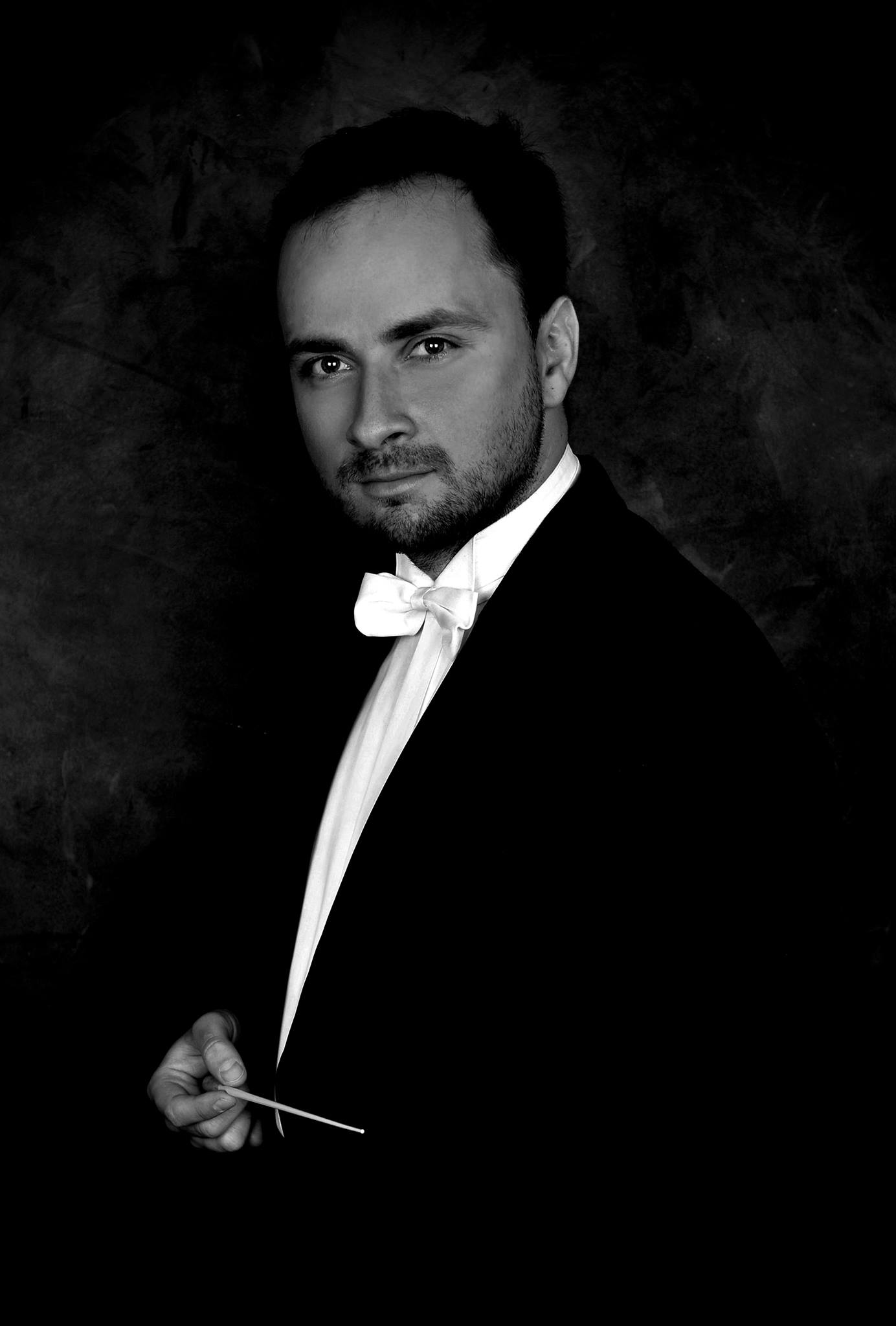 Ho osservato da vicino la carriera di Jakub Kontz a cominciare dal periodo dei suoi studi di direzione d’orchestra presso l’Accademia di Musica K. Lipinski di Breslavia. Già da allora si distingueva nel gruppo di studenti per l’approccio serio al lavoro, sviluppando non solo la tecnica e il talento musicale, ma anche i suoi orizzonti mentali, cosa estremamente importante nelle discipline umanistiche e nelle professioni artistiche. Durante il periodo accademico, Jakub Kontz ha avuto il suo primo clamoroso successo. Il suo debutto come direttore d’orchestra è avvenuto a fianco del Maestro Kurt Masur. Il famoso maestro ha selezionato per la masterclass internazionale solo una persona tra tutti gli allievi di direzione provenienti da Breslavia: Jakub Kontz. La masterclass si è conclusa con un concerto con la Wroclaw Philharmonic Orchestra (oggi l’Orchestra Sinfonica del Forum Nazionale di Musica).
Ho osservato da vicino la carriera di Jakub Kontz a cominciare dal periodo dei suoi studi di direzione d’orchestra presso l’Accademia di Musica K. Lipinski di Breslavia. Già da allora si distingueva nel gruppo di studenti per l’approccio serio al lavoro, sviluppando non solo la tecnica e il talento musicale, ma anche i suoi orizzonti mentali, cosa estremamente importante nelle discipline umanistiche e nelle professioni artistiche. Durante il periodo accademico, Jakub Kontz ha avuto il suo primo clamoroso successo. Il suo debutto come direttore d’orchestra è avvenuto a fianco del Maestro Kurt Masur. Il famoso maestro ha selezionato per la masterclass internazionale solo una persona tra tutti gli allievi di direzione provenienti da Breslavia: Jakub Kontz. La masterclass si è conclusa con un concerto con la Wroclaw Philharmonic Orchestra (oggi l’Orchestra Sinfonica del Forum Nazionale di Musica).
Jakub Kontz è un artista completo: laureato non solo in direzione d’orchestra ma anche in filosofia presso l’Università Adam Mickiewicz di Poznan, e, nella stessa Università, per la passione che nutre per l’Italia, ha studiato per qualche tempo anche filologia Italiana. Poi si è dedicato alla direzione d’orchestra per l’opera lirica, sotto la guida del M ° Donato Renzetti. Si è laureato nel 2006, dirigendo un concerto con la Wroclaw Philharmonic Orchestra e ha iniziato subito una intensa attivita’ professionale. Si è esibito in Polonia, Repubblica Ceca, Austria, Germania e in Italia. Da diversi anni fa parte in modo permanente della Baltic Opera di Danzica, dove ha diretto il Don Giovanni di Mozart, il Rigoletto e La Traviata di Verdi, Lo Schiaccianoci di Tchaikovsky, Maria di Statkowski. Nel mese di dicembre 2011, è stato direttore musicale della prima della Cenerentola di Prokofiev, con la coreografia di Eugenio Scigliano. Lo spettacolo ha ottenuto grande consenso da parte del pubblico e della critica ed è stato regolarmente segnato nel cartellone del teatro di Danzica. Infine, il successo della prima ha consentito ad Jakub Kontz di ricoprire per tre stagioni artistiche il ruolo di direttore musicale della Baltic Opera. Oltre al lavoro regolare a Danzica ha collaborato con altre orchestre polacche (l’Orchestra Sinfonica Polacca Iuventus, l’Orchestra Sinfonica della Filarmonica di Pomerania). I recenti successi sono un concerto con l’Orchestra Sinfonica della
Filarmonica Nazionale di Varsavia con la quale ha diretto musiche di I. Stravinsky e F. Poulenc e direzione del la Grand Opera Gala presso Polish Baltic Philharmonic Symphony Orchestra. Ha inoltre collaborato con l’ungherese Szeged Symphony Orchestra durante il Festival e Concorso Internazionale Armel (durante il quale si è anche seduto in giuria).
La Traviata di Danzica è stata condotta con padronanza da un direttore che conosceva la partitura a memoria: ha pensato ogni gesto, costruendo sin dalle prime battute l’esecuzione drammatica. Il direttore ha affrontato con brillante maestria le complessità della partitura, la cui fattura musicale, apparentemente semplice, era una sfida dal punto di vista espressivo. Già nel Preludio, difficile dal punto di vista interpretativo, ha adottato interessanti soluzioni dinamiche unite a rigore trasmesso all’orchestra, che aveva una sonorità complessiva piena ed armonica, nella quale talvolta emergeva liricamente la sezione dei violoncelli, prediletti da Verdi stesso.
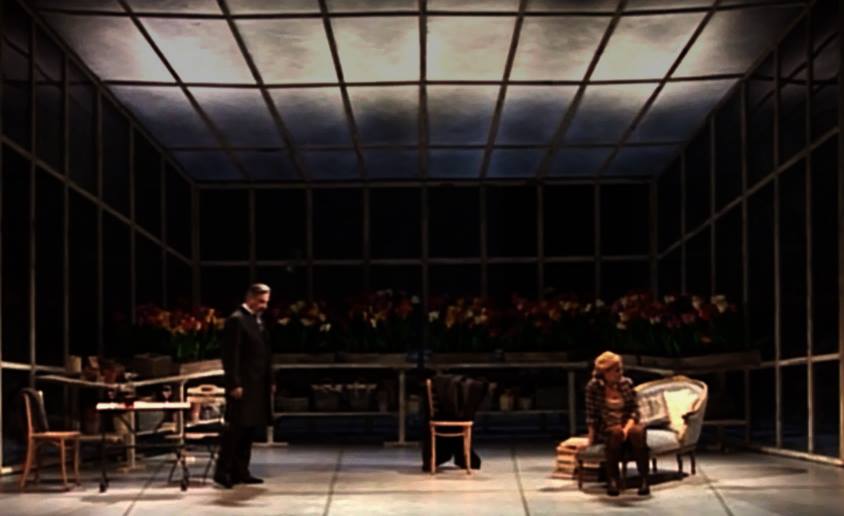 Nel ruolo di Violetta, ho visto una giovane cantante impegnata ogni giorno all’ Opera di Breslavia, Aleksandra Kubas – Kruk, che da diversi anni sta costruendo una importante e meritata carriera professionale. Tra i suoi più importanti successi vi sono: Primo Premio e Premio Speciale della Fondazione “Bogna Sokorska” come soprano di coloratura al VII Concorso Internazionale di Canto S. Moniuszko a Varsavia. L’artista nel ruolo di Violetta non mostra solo un perfetto abbinamento della voce, ma anche ottime condizioni fisiche. È una donna molto attraente e versatile e per questo potrebbe recitare in modo convincente le scene della tentatrice (I Atto) e della donna che sta morendo di tubercolosi (Atto III). Aleksandra Kubas-Kruk ha dominato praticamente tutti i protagonisti e si è evoluta di atto in atto sia vocalmente che teatralmente. Grande la scena del primo atto di Violetta: è strano – Ah, fors’è lui – Sempre libera: era solo un warm-up per il meraviglioso duetto con Giorgio Germont. Così, l’aria dell’ultimo atto Addio al passato si è mostrata nella sua delicatezza del piano (chiarissime e intonate le note della cantante) e nella sua capacità di commuovere.
Nel ruolo di Violetta, ho visto una giovane cantante impegnata ogni giorno all’ Opera di Breslavia, Aleksandra Kubas – Kruk, che da diversi anni sta costruendo una importante e meritata carriera professionale. Tra i suoi più importanti successi vi sono: Primo Premio e Premio Speciale della Fondazione “Bogna Sokorska” come soprano di coloratura al VII Concorso Internazionale di Canto S. Moniuszko a Varsavia. L’artista nel ruolo di Violetta non mostra solo un perfetto abbinamento della voce, ma anche ottime condizioni fisiche. È una donna molto attraente e versatile e per questo potrebbe recitare in modo convincente le scene della tentatrice (I Atto) e della donna che sta morendo di tubercolosi (Atto III). Aleksandra Kubas-Kruk ha dominato praticamente tutti i protagonisti e si è evoluta di atto in atto sia vocalmente che teatralmente. Grande la scena del primo atto di Violetta: è strano – Ah, fors’è lui – Sempre libera: era solo un warm-up per il meraviglioso duetto con Giorgio Germont. Così, l’aria dell’ultimo atto Addio al passato si è mostrata nella sua delicatezza del piano (chiarissime e intonate le note della cantante) e nella sua capacità di commuovere.
Bisogna menzionare anche Leszek Skrla, brillante nell’interpretare il ruolo di Giorgio Germont e il bravissimo tenore Paweł Skałuba nei panni di Alfredo.
Tra gli altri cantanti occorre ricordare Karolina Sikora nel ruolo di Flora che si era già presentata con forza nel primo atto da vero mezzosoprano verdiano. Anche se il ruolo di Flora era di carattere episodico, l’artista era in grado di creare una performance indimenticabile, non solo come cantante, ma anche come attrice. Nel secondo atto è stata favorita da un costume spettacolare, da sembrare la famosa Pola Negri.
Bene anche il coro, che si e’ presentato come un complesso dal suono solido, in grado di comunicare le diverse tonalità emotive incluse nella partitura. Nella scena del ballo mancava purtroppo un po’ di forza: meno numeroso il coro maschile, ma molto efficaci le voci femminili. Ho anche apprezzato la danza della Zingara, creata da Elżbieta Czajkowska-Kłos – in una coreografia di Roman Komassa.
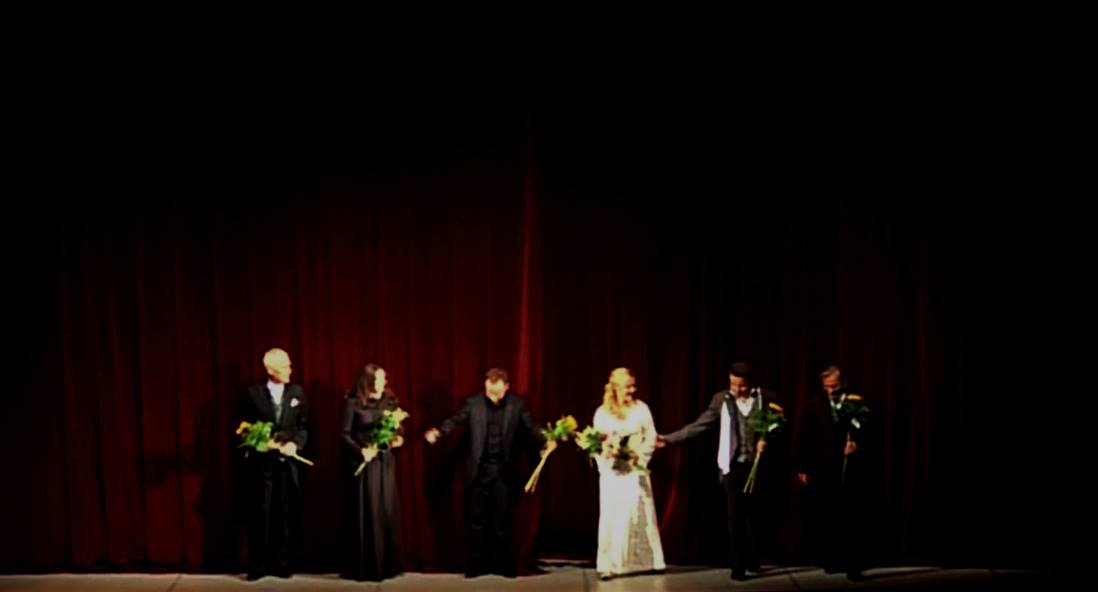 Originale mi è sembrata l’idea di concludere col secondo quadro del secondo atto (molto dinamico, pieno di movimenti) a sipario chiuso, che al pubblico si mostrava come una visione statica, che, senza gli oggetti di scena e le decorazioni, lo aiutava a concentrarsi sulla musica. I tre personaggi principali erano proiettati sul pubblico, come nell’antico teatro greco (sensazione amplificata dal costume di Violetta in stile classicheggiante). Si è trattato di un richiamo alla natura intima di questa partitura che ha permesso di sperimentarne quasi tangibilmente contenuti, emozioni ed eventi tragici. Vale la pena menzionare anche la scenografia (Hanna Szymczak) e i costumi, bellissimi soprattutto nella scena del ballo. La scena in cui si svolgeva l’azione della prima parte del secondo e terzo atto poteva essere interpretata non solo letteralmente, ma anche in modo simbolico: una sorta di vetro di copertura, dietro il quale i personaggi principali nascondevano il loro amore e se stessi per proteggersi dalla sporcizia di questo mondo. Questa idea interessante ha permesso l’uso di giochi di luce, che corrispondevano ai mutevoli umori di Violetta.
Originale mi è sembrata l’idea di concludere col secondo quadro del secondo atto (molto dinamico, pieno di movimenti) a sipario chiuso, che al pubblico si mostrava come una visione statica, che, senza gli oggetti di scena e le decorazioni, lo aiutava a concentrarsi sulla musica. I tre personaggi principali erano proiettati sul pubblico, come nell’antico teatro greco (sensazione amplificata dal costume di Violetta in stile classicheggiante). Si è trattato di un richiamo alla natura intima di questa partitura che ha permesso di sperimentarne quasi tangibilmente contenuti, emozioni ed eventi tragici. Vale la pena menzionare anche la scenografia (Hanna Szymczak) e i costumi, bellissimi soprattutto nella scena del ballo. La scena in cui si svolgeva l’azione della prima parte del secondo e terzo atto poteva essere interpretata non solo letteralmente, ma anche in modo simbolico: una sorta di vetro di copertura, dietro il quale i personaggi principali nascondevano il loro amore e se stessi per proteggersi dalla sporcizia di questo mondo. Questa idea interessante ha permesso l’uso di giochi di luce, che corrispondevano ai mutevoli umori di Violetta.
La presenza di centinaia di spettatori conferma la mia constatazione che La Traviata di Baltic Opera, diretta da Carolina Sofulak e brillantemente eseguita da Jakub Kontz, merita grande apprezzamento. Tra i difetti includerei un libretto di sala mal preparato. Bella grafica, buon testo, ma notizie poco aggiornate sugli esecutori.
Una Traviata di così alto livello, con questo cast e così bene eseguita e diretta, è stato dunque un ottimo motivo per visitare Danzica.
Agnieszka Misiak
La Traviata from the Baltic Sea
Last Saturday (October 3) I went to Gdansk. I had two reasons to visit this charming town. Both strongly artistic and very pleasant. The first one was to see live the famous Last Judgement by Hans Memling. The triptych belongs to the collection of the National Museum in Gdansk. The second, not any less important reason was a repertory performance of Giuseppe Verdi’s La Traviata performed by the Baltic Opera, this time under the baton of Jakub Kontz. It was worth spending 6.5 hours each way on the train between Wroclaw and Gdansk to see such a brilliantly conducted La Traviata. I would venture to say that, in my opinion, La Traviata under the baton of Jakub Kontz is probably the best La Traviata I have heard and seen in Poland.
I’ve been following closely Jakub Kontz’s career since his conducting studies at the Karol Lipinski Academy of Music in Wroclaw. Even then, he stood out from the group of his peers thanks to his serious approach to work and the developing of not only his conducting technique and musical talent, but also of his mental horizons, which is extremely important in the humanities and in artistic professions.
During his studies Jakub Kontz achieved his first spectacular success. He debuted as a conductor alongside… Maestro Kurt Masur himself! The baton master qualified only one student for his course from among all the conducting students from Wroclaw. It was Jakub Kontz. The workshop ended with a performance of the Wroclaw Philharmonic Orchestra (today the National Forum of Music Symphony Orchestra).
Jakub Kontz is a comprehensively educated artist (graduate of not only conducting, but also of philosophy at the Adam Mickiewicz University in Poznan, where out of his love for Italy he also studied Italian Philology for some time). He then further supplemented his conducting studies in Italy in the field of opera conducting under the tutelage of Maestro Donato Renzetti. He graduated in 2006, conducting a concert with the Wroclaw Philharmonic Orchestra and immediately began an active career as a conductor. He has performed in Poland, the Czech Republic, Austria, Germany and Italy. For several years he has been permanently associated with the Baltic Opera in Gdansk where he conducted such performances as Mozart’s Don Giovanni, Verdi’s Rigoletto and La Traviata, Tchaikovsky’s Nutcracker, and Statkowski’s Maria. In December 2011, he became the music director of the premiere of Prokofiev’s Cinderella, choreographed by Eugenio Scigliano. The show, which was received with much applause, visited the Gdansk stage regularly. The success of the premiere made Jakub Kontz take up the post of the Baltic Opera music director for three seasons. Apart from the regular work in Gdansk, he also collaborated with other Polish orchestras (e.g. The Polish Sinfonia Iuventus Orchestra, The Symphony Orchestra of the Pomeranian Philharmonic). One of his recent achievements was a concert with The Symphony Orchestra of Warsaw National Philharmonic (he conducted works by I. Stravinsky and F. Poulenc) and conducting the Grand Opera Gala in The Polish Baltic Philharmonic Orchestra. He also collaborated with the Hungarian Szeged Symphony Orchestra at the international opera festival and the Armel competition (during which he was also a jury member).
La Traviata in Gdansk was conducted with a steady hand. It was evident that the conductor knows the score by heart, has thought out every gesture, from the first bars consistently building the dramaturgy and brilliantly coping with the complexities of the orchestra part which – seemingly texturally simple – is extremely expressively difficult in La Traviata. Starting already at the tricky, interpretively difficult Preludio beginning Act 1, one could observe the Italian cantilena thinking, interesting dynamic solutions and leading iron discipline, which influenced the orchestra. The cellos, so beloved by Verdi, were given much attention. The orchestra’s sound was saturated.
I was very pleased to see a young singer working normally for the Wroclaw Opera – Aleksandra Kubas-Kruk in the role of Violetta. For several years she has been building a very successful and fully deserved singing career. From among her most important accomplishments it is worth mentioning the 1st Prize and the Award of the B. Sokorska Foundation for the best coloratura voice in the 7th International Stanislaw Moniuszko Vocal Competition. The artist has not only perfectly matched the voice but had also a perfect physical condition for the role of Violetta. She is a very shapely, frail, attractive woman, so she is able to convincingly play the scenes of the underworld temptress (Act 1) and a person dying of tuberculosis (Act 3). How many times one sees on stage a Violetta who does not look credible in the role of a person suffering from tuberculosis… Aleksandra Kubas-Kruk dominated basically all the singers and evolved vocally and acting-wise from one act to another. The great Violetta scene from Act 1 – È Strano – Ah, Fors’è Lui – Sempre Libera – was just a warm-up to the wonderful duet with Germont, and in the last act aria Addio del passato she struck with authenticity and the piano that electrified the audiences. The singer has excellent ear – she sung all the sounds with extreme cleanliness and precision.
The experienced Leszek Skrla in the role of Giorgio Germont and Paul Skałuba as Alfredo gave interesting performances, as well.
As for the other singers, Karolina Sikora genuinely surprised me with a Verdi‑style mezzo‑soprano already in Act 1. Although the character of Flora is definitely asecondary role, even episodic, the artist was able to create an unforgettable performance not only singing, but also acting. In the second act she had the help of a spectacular ball gown, in which she resembled the famous Pola Negri.
The choir, which presented itself as a team with a solid sound, capable of capturing various emotional shades of the score, performed very well. In the ballroom scene, against the unfortunately less numerous male choir, ladies looked especially well. It is also worth mentioning the interesting dance role of the Gypsy, created by Elżbieta Czajkowska-Kłos – in the interesting choreography by Roman Komassa.
I found the idea of conducting the finale of the second part of Act 2 (which was all very dynamic and full of motion) statically, in front of the curtain, very interesting – closer to the audience rather than on stage, among the props and decorations. Approaching the audience, especially of the three main characters (like in the ancient Greek theatre, which association was also intensified by Violetta’s gown styled as an ancient robe) reminded of the intimate nature of this work and allowed to experience almost tangibly the emotions and the tragedy of events contained therein. It is also worth mentioning the well-thought-out stage design (Hanna Szymczak) and impressive costumes in the ballroom scene. The greenhouse where the first image of Act 2 and Act 3 took place could be received not only literally, but also symbolically, as the glass cover, under which, the main characters hid their
love and themselves among colourful tulips to protect their feeling from the dirt of this world. This interesting idea has allowed to use the play of light corresponding to the changing moods of Violetta.
One hundred percent attendance of the spectators only confirmed my observation that the Baltic Opera La Traviata, directed by the great Karolina Sofulak, brilliantly conducted by Jakub Kontz, is widely appreciation.
One of the downsides of the show was a poorly prepared programme booklet. Beautiful layout, good text, but… the information about the performers has not been fully updated.
To sum up my impressions in one sentence – I think that La Traviata in such cast and under such musical direction is definitely worth a trip to Gdansk.
Agnieszka Misiak


